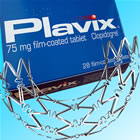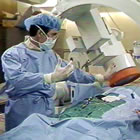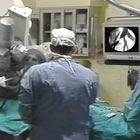 If you’re an interventional cardiologist, Fellow, or in the allied health fields, and you aren’t able to make it to Washington for the five-day-long TCT meeting, you can get a quick dose of the latest and greatest in a single day on Saturday, September 20, in Short Hills, New Jersey.
If you’re an interventional cardiologist, Fellow, or in the allied health fields, and you aren’t able to make it to Washington for the five-day-long TCT meeting, you can get a quick dose of the latest and greatest in a single day on Saturday, September 20, in Short Hills, New Jersey.
Titled “Frontiers in Interventional Cardiology,” this symposium is presented by the Morristown Medical Center, part of the Atlantic Health System, and features a stellar international faculty, including Maurice Buchbinder, George Dangas, Eberhard Grube, Raoul Bonan, and Stephen Ellis. A range of contemporary topics are on the agenda, including a transradial talk by pioneer Olivier Bertrand, discussions about catheter-based treatments for mitral and aortic valve disease, and even a brief talk about Google Glass in the cath lab by Morristown Medical Center’s Jordan Safirstein, who also runs the annual MARS radial course at Morristown Medical Center
Course co-directors are Drs. Maurice Buchbinder, Barry Cohen and Robert Kipperman. Time is short so register soon. Admission fees range from free (for Fellows) to $125 for physicians, with several levels in-between. You can register for the course online, or call 1-800-247-9580.
Did I mention that Fellows are free? #TakeAdvantageOfFreeCoursesWhileYouCanFellows
 Almost two decades ago, interventional cardiology pioneer Dr. Spencer B. King III penned an article for Circulation titled, “Angioplasty From Bench to Bedside to Bench.” Dr. King’s article was a recounting of the history of the development of the angioplasty balloon catheter by his colleague at Emory University, Andreas Gruentzig.
Almost two decades ago, interventional cardiology pioneer Dr. Spencer B. King III penned an article for Circulation titled, “Angioplasty From Bench to Bedside to Bench.” Dr. King’s article was a recounting of the history of the development of the angioplasty balloon catheter by his colleague at Emory University, Andreas Gruentzig.
 No one thought it would take quite so long to get this information, but in just a couple hours results from
No one thought it would take quite so long to get this information, but in just a couple hours results from 
 This week started off with me watching a demonstration of fractional flow reserve (FFR) during multivessel PCI. This very instructive case was transmitted live from Hammersmith Hospital in London and featured Dr. Justin E. Davies showing how to perform FFR and, more importantly, how the use of FFR changed the treatment plan for this patient.
This week started off with me watching a demonstration of fractional flow reserve (FFR) during multivessel PCI. This very instructive case was transmitted live from Hammersmith Hospital in London and featured Dr. Justin E. Davies showing how to perform FFR and, more importantly, how the use of FFR changed the treatment plan for this patient. The coronary angiogram is often referred to as a road map of the heart. As such, it serves the cardiologist and cardiac surgeon well. It shows where the coronary arteries are, how they intersect, the angles of the branches, etc. There are diagrams of these anatomical features in many textbooks, but the reality is that these characteristics can vary from individual to individual, so it’s necessary to get a road map for each individual in whom an intervention is being contemplated. Then, of course, there’s the issue of narrowings in the coronary arteries. Should these receive stents? Should they be bypassed? Should they be left alone and treated with medical therapy?
The coronary angiogram is often referred to as a road map of the heart. As such, it serves the cardiologist and cardiac surgeon well. It shows where the coronary arteries are, how they intersect, the angles of the branches, etc. There are diagrams of these anatomical features in many textbooks, but the reality is that these characteristics can vary from individual to individual, so it’s necessary to get a road map for each individual in whom an intervention is being contemplated. Then, of course, there’s the issue of narrowings in the coronary arteries. Should these receive stents? Should they be bypassed? Should they be left alone and treated with medical therapy?  If you’re an interventional cardiologist, Fellow, or in the allied health fields, and you aren’t able to make it to Washington for the five-day-long TCT meeting, you can get a quick dose of the latest and greatest in a single day on Saturday, September 20, in Short Hills, New Jersey.
If you’re an interventional cardiologist, Fellow, or in the allied health fields, and you aren’t able to make it to Washington for the five-day-long TCT meeting, you can get a quick dose of the latest and greatest in a single day on Saturday, September 20, in Short Hills, New Jersey. It’s been
It’s been 

